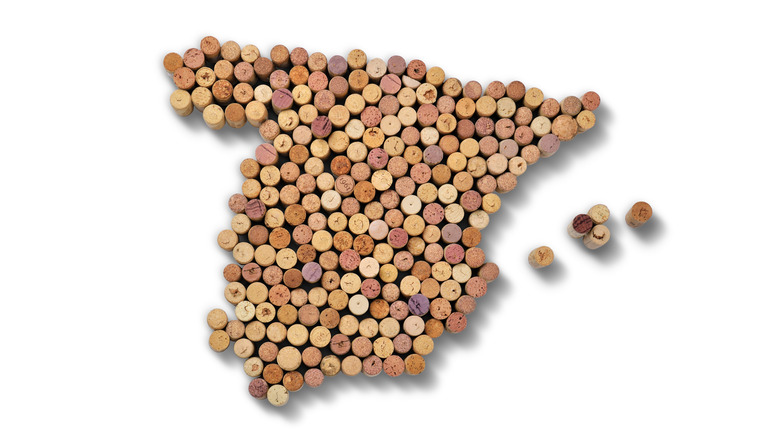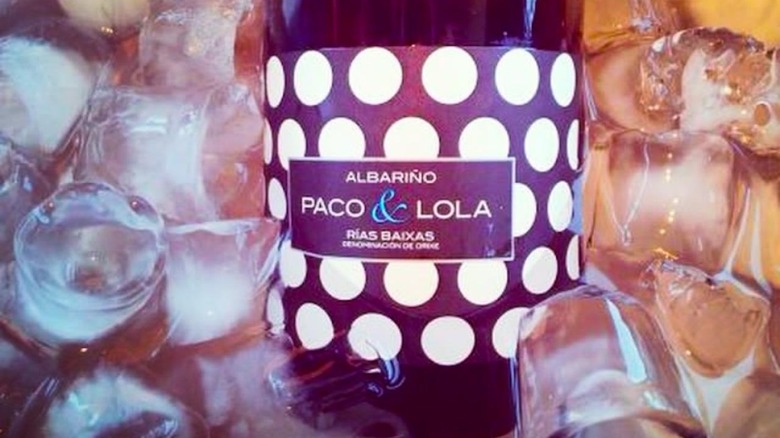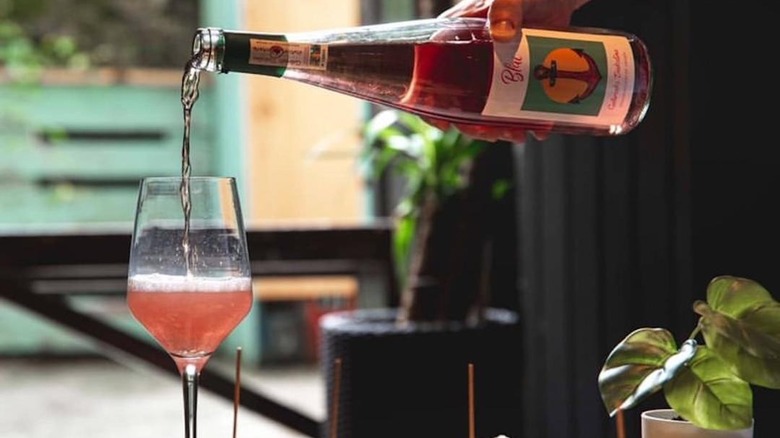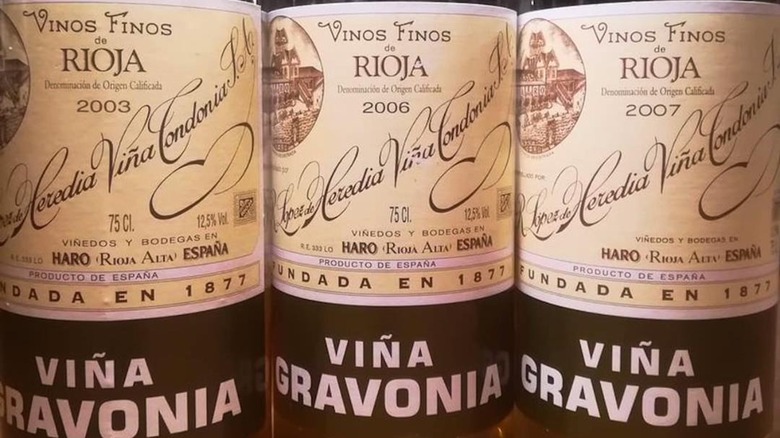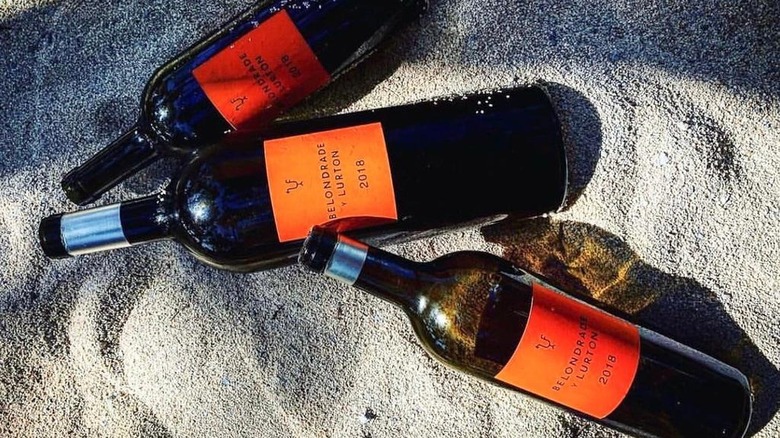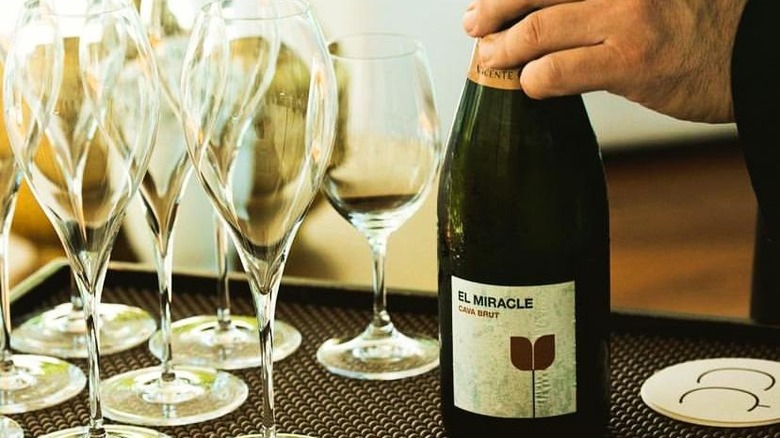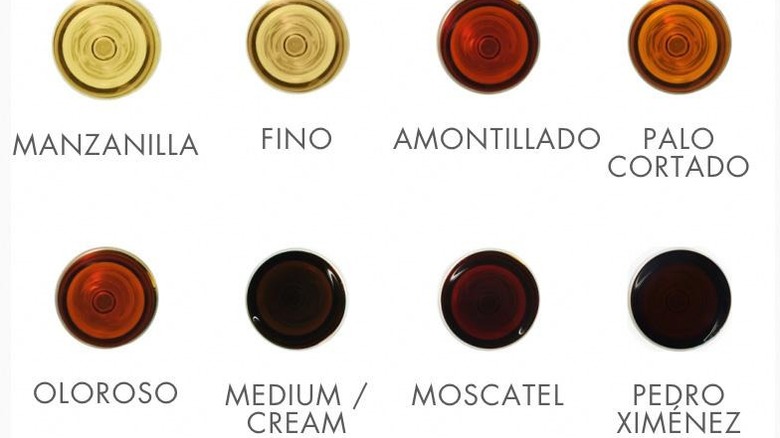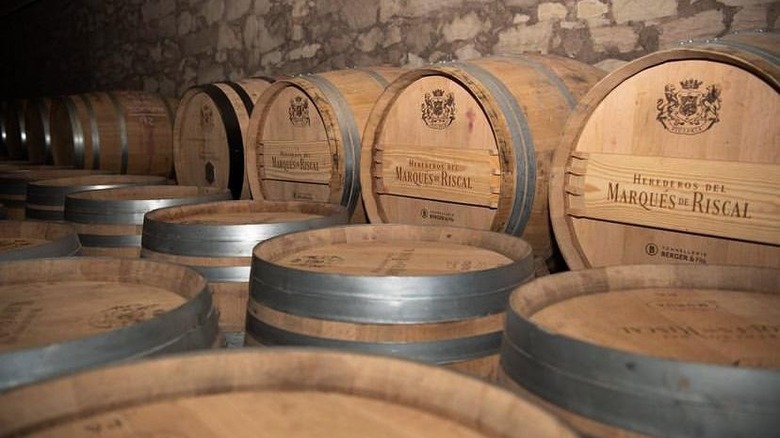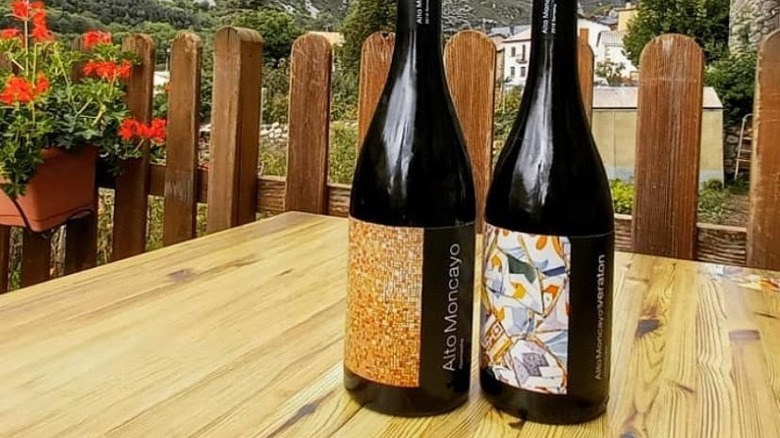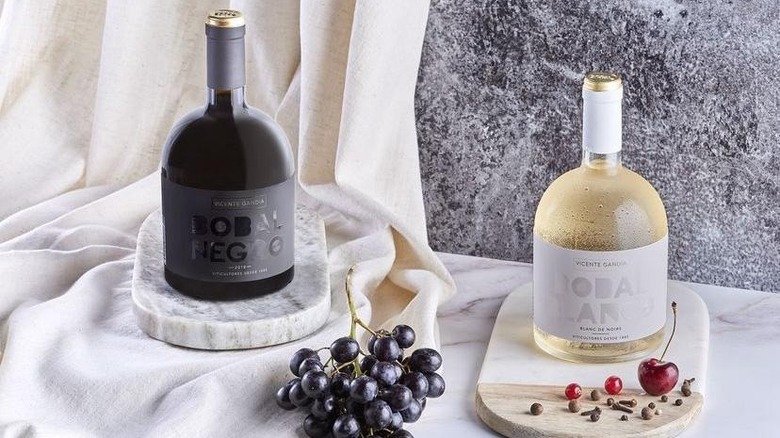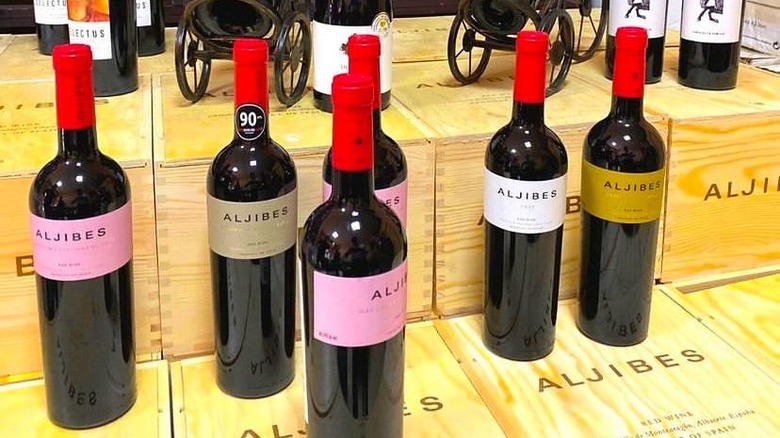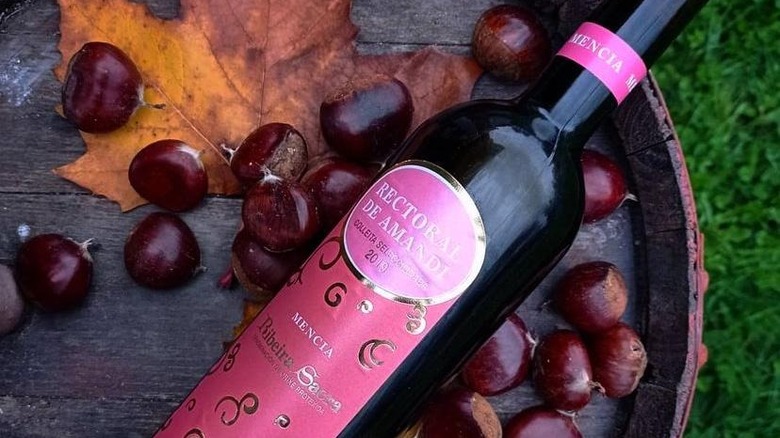Explore Spain With These 13 Wines
Spain is Europe's farthest west country, a claim it shares with Portugal. Spain Then and Now reports that the country's geography is wildly varied with the most mountain ranges in Europe next to Switzerland, a vast and arid central plateau, subtropical regions, and a balmy Mediterranean climate to the southeast that lends itself to a copious variety of wines.
BKWines' 2020 report claims that Spain is the third-largest wine producer in the world, pumping out 40.7 million hectolitres of juice in 2020. A champion of native varietals (Spain has over 600), most commercially released wines come from just a handful of grape varietals, according to The Wine Bible.
Spain takes tradition and culture seriously when it comes to life, cuisine, and wine. Many Spanish winemakers shy away from modern trends toward globalization and homogenization of styles and flavors. That doesn't mean they haven't embraced modern technology. Spanish winemakers employ cutting-edge techniques aimed at sustainability and regenerative agriculture while maintaining a luscious rustic quality in their uniquely Spanish wines.
Wines of Spain divides the country into seven wine-making regions that exemplify terroir, that geographic and cultural signature that European wine is prized for. Explore Spain and its wonderful diversity by sipping on these 13 distinct wine varietals.
Albariño
Albariño is a floral and fruit-forward white grape varietal that thrives in the rainy and cool northwest Atlantic coastal region of Spain called Rías Baixas, in Galicia. The grape produces wine with notes of kiwi, honeydew, nectarine, ruby red grapefruit, and a zesty salinity that is delightfully clean according to WineFolly. It pairs well with the seafood that is abundant along the Atlantic coast.
Try Paco & Lola, a modernist wine project focused on consumer-friendly wines that was founded in 2005. Paco & Lola produces a range of white, red, and sparkling wines, but their claim to fame is their fruity-floral albariño. With peach-scented crème-brulée notes, their wine is a classic — especially when paired with grilled fish or a meal of briny mollusks. Martin Codax was the first producer to import their albariño to the United States back in 1988, and it's been a popular selection ever since.
Txakolina and hondarrabi zuri
Txakoli is an exceptionally tangy and bright wine, primarily produced from the hondurrabi zuri grape native to the Basque country. The region is situated in northwest Spain around the city of San Sebastián and the Bay of Biscay.
Wine Folly says that the region is known for its lime-forward and zesty herbal white wines, low in alcohol and high in acidity, with a touch of effervescent spritz, Txakolina is one of the most refreshing and food-friendly white wines from Spain. Basque also produces delicious red and rosé wines with raspberry, blackberry, and lime notes, alongside rustic hard apple cidres.
Blai Txakolina is relatively new on the scene. Launched in 2019, Blai produces five gorgeous, modern txakoli wines from hondarrabi zuri, hondarrabi beltza, petit corbu, and a splash of Riesling. Perhaps the most famous txakoli in the United States is the iconic Ameztoi Txakolina in its emerald green towering bottles. Wine producers since 1820, Ameztoi is as classic as it gets. They produce a white, red, and rosé Getariako Txakolina D.O. in a modern style as well as a rustic Kirkilla.
Viura / Macabeo
Viura is the main white wine grape grown in the Aragon, Rueda, and Rioja regions of Spain. It is called macabeo in other regions and is one of the three traditional grapes used to produce Cava, Spain's most famous sparkling wine. WineGeeks suggests that viura smells and tastes like wildflowers and bitter almonds with moderate acidity and body. Viura often exhibits pear and green apple notes and depending on how it is made, can have a creamy texture. The Wine Society indicates that viura is used in 90% of all white wines produced in Rioja.
The legendary Bodegas R. López de Heredia Viña Tondonia, known for its adherence to traditional styles and rustic red wines, crafts an indelible white wine from a 100% viura called Viña Gravonia. It exudes smoky nuanced notes layered with white flowers, peach, and pear, juxtaposed with a clean mineral finish. Finca Allende by Miguel Angel de Gregorio also produces a modern, fresh, fruity viura with citrus and peach notes.
Verdejo
Delicate and thin-skinned, verdejo thrives in northwest Spain where it is the main grape grown in the Denominación de Origen of Rueda in Castilla y León (via Simply Spanish Wine). According to Ribera y Rueda, Rueda is hot, dry, windy, and inhospitable for most crops, but winemakers have been growing vines there for over a thousand years. Verdejo, originally from North Africa, acclimated to the harsh environment and makes up more than 90% of the wine production in the region. The grape is also grown in small quantities in other regions across Spain.
Verdejo is a white grape that produces fresh, crisp, and herbal wines with notes of green apple, lime zest, green melon, balsam, and fennel. It is a perfect food wine that pairs well with spiced and aromatic Spanish fare, Japanese and Thai food, along with Indian and Mexican cuisine.
Be sure to check out Belondrade Y Lurton from Reuda. It is a high-end expression of verdejo that spends ten months aging on the lees to impart a creaminess to the wine. Jorge Ordóñez Bodegas Vatan Nisia Verdejo Old Vines, also from Reuda, is a richer style as it spends some time in oak to soften its racy acidity. It exudes floral vanilla notes alongside ripe apples and pear.
Airén
LaMancha Wines reveals that airén is often a blending grape that's used to add acidity to white wines and remove heft from reds. It is also used to make Spanish brandy, a grape distillate similar to French cognac, that can be consumed neat or as a part of blended cocktails. It is also the main spirit used to fortify sherry wines, reports ThristyMag.
When it comes to airén, you'll find green and herbal notes alongside juicy pineapple, white grapefruit, crisp yellow apples, and a floral touch of white tea roses. Airén can be hard to find as a stand-alone varietal so look for blends and modern producers that champion the grape.
Bodegas Campos Reales makes a mouthwatering blend of airén and sauvignon blanc in La Mancha that delivers all the promise of sauvignon blanc with a distinctly Spanish twist. Los Galanes Blanco 2009 (from Santa Catalina), exhibits the aromatic floral range of airén along with crunchy green pear and a hint of ripe kiwi.
Cava
Cava is a gorgeous sparkling wine made in the same traditional method as champagne and rivals the best sparkling wines in the world — at a fraction of the price. Traditionally, Spaniards used a trifecta of grapes including macabeo, parallada, and xerel-lo. These days, it is common to find classic Champagne grapes, like chardonnay and pinot noir, in the blend. Cava is a fruity and light wine with ultra-fine mousse (bubbles) and notes of quince, lime, chamomile, almonds, pear, and in riper styles, fleshy peach or apricot.
Freixenet and Segura Viudas are two of the oldest Cava producers in Spain, reaching back to the 12th century. But they're staying fresh with forays into organic and non-alcoholic sparkling wines.
Vincente Gandia, nestled along the Mediterranean coast near Valencia, takes a sustainable approach to winemaking and focuses on organic grapes for their prized wines. Gandia produces two Cavas: El Miracle brut cava from organic macabeo and chardonnay and a gorgeous rosé cava from garnacha. Both wines are fresh, fruity, floral, and possess a delightfully playful bubbly mousse that tantalizes the tongue.
Sherry
Sherries are incredible wines that are versatile, food-friendly, and can last for weeks once opened (if stored properly). Sherry isn't a single wine, but a category of fortified wines crafted with the palomino, Pedro Ximénez, and moscatel grapes from the Jerez de la Frontera or Jerez region in Cádiz, Andalucía, Spain. It is there, in a balmy subtropical climate, that sherry is produced. Unique in the world of wine, sherry comes in a range of styles from bone dry and pungent to thick as syrup and laden with nutty dried fruit aromas.
The World of Spanish Wines details the different types of sherry, listing fino and manzanilla as the driest styles. They exhibit briny saline notes and taste similar to a dry vodka martini. The remaining sherries are exposed to oxygen during their aging process, giving them a nutty flavor that increases with the duration of oxidation. Listed in order of oxidation, body, and sweetness from lightest or boldest: amontillado, palo cortado, oloroso, medium cream, cream, and Jerez dulce. Moscatel and PX (or Pedro Ximénez) — with honeyed, floral, and orange blossom notes — are delicious sweet fortified wines produced in the region and farther afield.
Sherries are fortified to lengthen their life, particularly important in pre-refrigeration Spain. These days, it is to maintain their singular style. There are dozens of sherry producers but Bodegas Lusta, Bodegas Hidalgo la Gitan, and Tio Pepe have been importing their wines to the United States for decades.
Tempranillo
Tempranillo is emblematic of Spanish wine and is grown in nearly every wine-producing region in Spain. Expressing ripe cherry, kirsch, and blackberry notes with wet saddle leather, cola, pipe tobacco, cedar, and balsam undertones, tempranillo is a perfect food wine. The Wine Society claims that Rioja is Spain's most important region, and tempranillo is Rioja's most important grape. Its herbal and leathery notes express the essence of the elegant yet feral country that is the wild west of Europe. Spanish winemakers age tempranillo for years before it is released, giving the rustic grape finesse and elegance.
Marqués de Riscal has been producing quality wines in Rioja since 1958 when the region was settled by Bordelaise looking for fresh frontiers. Known for its state-of-the-art, Frank Gehry-designed winery and its classic tempranillo wines, Riscal also produces a broad range of white and rosé wines.
The mysterious and legendary Vega Sicilia is located in Ribera del Duero. The region transforms tempranillo into an elegant wine juxtaposed against Rioja's robust style. Vega Sicilia believes in patience and often waits decades before releasing their wines to the world. Their 1962 Unico, released in 2012, was one of Spain's first 100-point wines.
Garnacha
Garnacha is an incredibly versatile wine that thrives around the wine-making world. In France, it's known as grenache, and in Sardinia, Italy, it's known as cannonau. It can be found in South Africa, Australia, Morocco, Tunisia, Algeria, and the Americas.
The grape, no matter where it is grown, produces a fruity, bold red wine with notes of plum, blackberry, dried herbs, and strawberry, and can exhibit woodsy, crushed herbs, and leathery notes. Garnacha makes a lush and fruity, strawberry-tinted rosé with bright acidity and a tangerine peel finish. It's also an incredibly food-friendly wine perfect for summer barbeques and leisurely picnics in the park with friends. Young garnacha wines are fruity and light — the perfect wine for Spain's classic summer punch: sangria.
Bodegas Jiménez-Landi in Méntrida uses biodynamic viticultural practices and is famous for its brawny and bold wines including Cantos Del Diablo, a deeply extracted, full-bodied, and flavored inky wine. Bodegas Alto Moncayo, from Campo de Borja, is relatively new on the scene. Founded in 2002, it's a champion of old-vine garnacha, in part because the grape expresses terroir more than most varieties adding a distinct signature taste to their wines.
Bobal
Of all the native Spanish grapes, bobal might be the easiest to sip and the hardest to find. It is a dark purple grape that produces a soft, fruity, light wine with notes of fresh berries, ripe plum, pomegranate, and a dusting of cocoa. It grows in the coastal region of Valencia and rarely anywhere else in Spain (or the world). If you enjoy a slightly chilled red on a hot summer day, bobal is the grape for you.
Bodegas Vincente Gandia is experimenting with the native bobal grape, making delightfully refreshing white, rosé, and red modern wines and packaging them in apothecary-style bottles. Not only is the packaging unique, but the wines are also one of a kind. Bobal Wine Cellars (BWC) is a cooperative of seventeen partners that are devoted to the elusive grape. With more than 22,000 hectares under vine, BWC produces about one million liters of wine annually.
Monestrall
Monastrell is another grape Spain shares with France, where it is called mourvèdre. Monastrell has a uniquely lavender and herbal undertone that is instantly recognizable. Add to this notes of ripe blackberry, bramble, mulberry, fresh pipe tobacco, and a peppery meaty quality, and you'll find that monestrell resembles syrah and tannat in its flavor profile and high tannin structure. It is a big, bold wine that needs time in the bottle to decant, or a juicy steak to really enjoy it. With age, the wine becomes more refined and less feral, exhibiting a velvety cocoa finish rather than the gritty and chewy tannic one found in its youth.
Bodegas Alejandro Arbui excels at producing a modern yet brawny style from the rustic monastrell grape. Arbui is thick and aromatic with balsam, crushed herbs, and ultra ripe fruit that benefits from cellar aging. Bodegas Volver also crafts a youthful and modern monastrell called Tarima that is drinkable young.
Alicante bouschet (garnacha tintorera)
Alicante Bouschet, also called garnacha tintorera, resembles monastrell in body and style but exhibits a fruitier and smokier quality. A French cross between grenache (garnacha) and petit bouschet, it thrives along the Mediterranean sea in southern France and Spain. It can be found in Tunisia, Italy, the Americas, and Turkey. Alicante Bouschet is perhaps most popular in the Algarve region of Portugal, which accounts for most of the imports to the United States.
Alicante Bouschet is a full-bodied wine with moderate acidity and tannins with flavors of black fruits, including black cherries, black plums, and blackberry. It has an herbal, bramble quality that can be perceived as slightly cool. It pairs wonderfully with cured and grilled meats and with sweet barbecue-sauced beef. Spice can make the wine seem bitter.
Castillian producer, Finca Los Aljibes, crafts its Aljibes red wine from garnacha tintorera, which is spicy with deep fruit notes and pungent aromas. The producer uses the grape for blending in many of its wines including their VA Viña Aljibes blend with cabernet sauvignon, syrah, and petit verdot. Bodegas Luzón is another producer that champions the grape in Spain. Their Colección 8 Meses Garnacha Tintorera is a bold, inky, fruit-driven wine with ultra-ripe black fruit, licorice, molasses, and ripe dates finished with a dusting of cocoa and mint.
Mencía
Mencía is an up-and-coming native grape that is gaining popularity outside of its native Spain. It is softer in style than many Spanish grapes but has bright acidity and firm tannins that give it aging potential when produced in a serious style. It can be tangy with tart cherries, raspberries, currant, green strawberry, under-ripe red plum, tangerine zest, and rhubarb notes. Depending on its production style, mencía may spend time in oak barrels, imparting a clove and vanilla cola or toffee quality. When young or vinified in stainless steel, mencía can be a light and fruity wine perfect for wine spritzers, sangria, and cocktails.
Rectoral de Amandi is a popular and prolific wine producer, churning out two million bottles annually. Located in the Galicia region in Spain's most northwest corner, it produces a broad range of red and white wines and features an award-winning mencía collection: Colleita Seleccionada Mencía. Bodegas y Vinedos Luna Beberide's Finca Luna Bereride Mencía from the Bierzo region exhibits floral notes of pink and red roses, iris, and violets, along with rich bramble and berry notes and a ripe Luxardo cherry finish. It is a delectable wine with charcuterie and lighter fare.
